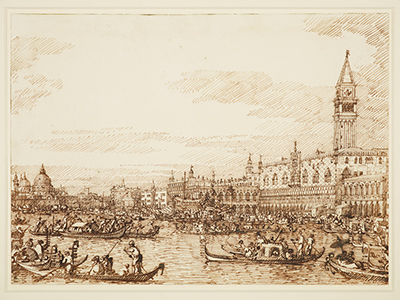Canaletto is one of the few artists from the 18th century to have had their drawings examined and documented in considerable detail. He produced a mixture of study sketches and genuine, completed artwork drawings.
We are thankful to the Royal Collection Trust in the UK for putting together an excellent recent exhibition which drew together many of his finest pieces in this medium and it allows us to look at a wide breadth of work together for the first time. The exhibition itself pulled in items from right across his career, from early drawings around San Marco to more complex pieces elsewhere in Venice as the artist became more technically skilled and also more confident. Canaletto was a precise artist, which was entirely necessary for the type of content that he depicted within all of his work, and we can get a better idea of this accuracy through his stripped-down drawings, where no oils were added on top. It essentially leaves behind a skeleton of his organic creations.
We do know that Canaletto would actually, on occasion, work entirely from his imagination and create cityscape scenes that were not actually based on any particular location. These would naturally have been influenced by the displays of grand architecture that he came across whilst travelling, and so would tend to follow similar styles to his other work. Perhaps he would wish to stay within his studio and work from his mind, when perhaps the weather was not to his liking or he simply wished to spend some time by himself. That said, most of his drawings are indeed of genuine places, most of which still remain much the same today, thanks to the continued efforts of architects and local councils to protect what are essentially items of historic importance.
As was the way during the 18th century, Canaletto used a quill pen over lines of feint pencil to put together most of his drawings. He would put plenty of planning in prior to completing individual details, which was essential to architectural depictions. He considered the perspective of each item and made use of pinholes in order to structure the piece in its early stages. It would be particularly difficult to make adjustments to shapes of buildings and other structures as the drawing progressed, potentially much harder than oils, where new layers can simply be applied each time. He understood this and so spent extra time in the earlier stages prior to worrying about the decorative detail across his scenes.
The real flair of Canaletto, where he used looser touches of brush or pencil, are found in the figures that he dots around many of his drawn scenes. They are added without as much concern for accuracy and are more meant as an approximation. They add life and personality to these artworks and also give the impression that the artist had put in less planning than he actually had. In some cases he would even construct figures with just a single main line, that is then embolden by additional touches, and this was more the case in the earlier periods of his career. Later on he added more interest to some of his figures, including washes that provided shadow. Much would also depend on the particular setting, and specifically how many figures were added, as well as how large each one was.
Research into the artist's career suggests that some of his earliest drawings were used as a method of selling a composition to a client, giving an indication of how Canaletto intended to complete a commission. He would have worked on these within his studio and invited guests to sign off his idea for the later painting. This would have saved time as opposed to having to make significant amendments at the stage at which oils were being added. He could also then use some of these drawings to tout for other business, as his career started to take off, when maybe he did not yet have many completed paintings to show off. A patron named Joseph Smith kept many of his early drawings within an album and this ensured their survival up to the present day.
Canaletto himself is unusual in that so many of his drawings remain in good condition and correctly attributed to the artist. This is perhaps because of the amount of work that went into many of them, so they would be treated with more case than the simple sketch work of other artists from around that period. Some of his customers would also truly value them and take care to look after them, almost as much as the completed paintings that they would have received at a later date. We can compare his work to, say, some of the Renaissance masters such as Michelangelo and Da Vinci who would tend to complete many different simple sketches together on the same page, and then continue on the other side in order to save this valuable resource.




